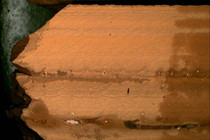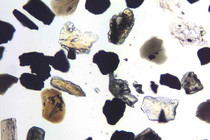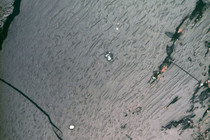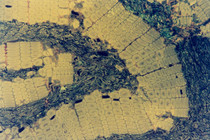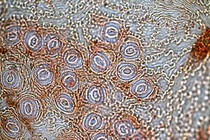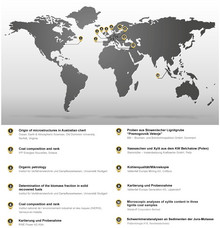Microscopy: optical and electron microscopy
Based on tens of years of experience we offer microscopic analyses of coals and organic matter. At our location in Lauta we are specialized in maceral and microlithotype analysis of lignite. On doing so, the main area of investigation is the identification and evaluation of refinement properties (briquetting ability). In Tübingen you receive the whole range of services of the organic petrology. We are equipped with a comprehensive archive of samples and preparations of worldwide organic matter.
Additionally we are active in the field of inorganic microscopy. Here, we are specialized in light and heavy mineral analysis. Besides our scanning electron microscope extends our range of service in order that the resolution of light microscopy is exceeded by far and reproduces the microstructures of true surfaces. This step of innovation is combined with the expertise of our staff in X-ray fluorescence analytics and the possibilities of micro chemical analysis by EDX. Our ZEISS EVO MA 10 is suitable for many analytical assignments and considers geological, material scientific as well as technical issues.
Consulting
Our consulting service involves extensive methods of microscopy of organic and inorganic matter.
- Lignite and coal: microlithotype analysis (QMAT), maceral analysis, vitrinite reflection, xylite selection and identification
- Coking coal microscopy and characterization of natural coking coals and thermal altered coals (e.g. coal seam fires in China)
- Identification of horizons of forest fire in coal seams and other sedimentary sequences
- Geology of fossil oil and gas (determination of composition, type and quantity of kerogen, determination of the degree of the maturity of bedrocks)
- Identification and characterization of bitumen and oil in rocks
- Fluorescence microscopy and measurement
- Microscopic evaluation of peat samples
- Pollen and cuticular analysis for facies classification in lignite and carboniferous clastic sediments as well as for stratigraphic correlation of seams, layers and corollary horizons
- Heavy mineral analysis for petrographic characterization of the sediments, stratigraphic statements and provenance-analysis
- Study of light minerals with focus on quartz and feldspar
- Scanning electron microscopy for high-resolution display and chemical analysis of geological, material scientific and technical samples
Research
- Organic petrology
- Paleobotany - Tertiary (coal)
- Biostratigraphy by use of pollen and cuticulas (Tertiary)
- Heavy mineral content and sedimentological character of selected samples of the Tertiary
- Study of clinker formation from power plant processes
Methods
We undertake the preparation of your samples for inorganic as well as organic-petrologic analyses. Among others our laboratory in Tübingen is specialized in the dry polishing of water sensitive samples.
- Sample processing (e.g. demineralization by HCl, HF)
- Preparation and production of polished sections
- Stereomicroscopic assessment
- Reflected-light microscopy
- Fluorescence microscopy and measurement
- Transmitted-light microscopy
- Scanning electron microscopy
- Photo documentation (electron-/microscopic pictures) also for technical objects
Projects
Microscopy: Study of clinker formation in power plant processes
At power plant processes the clinker formation within the scope of the flue gas line occurs at times, especially in the cyclones for fly ash separation. Such deposits have a disturbing effect on normal operation and therefore are object of further investigation.
Microscopy: Analysis of heavy minerals
Since several months we intensively deal with the analysis of heavy minerals in tertiary sands. In the process the sand is treated chemically and sieved subsequently. Now, for each obtained grain size range the light minerals are separated from the heavy ones. Latter, the group of heavy minerals, is characterized by a density of >2,9 g/cm³.
Microscopy: QMAT – Quantitative Micropetrographic Analysis with evaluation of Textite
QMAT is a coal-petrologic investigation method for qualitative statements about refinement properties. Studied are constituents (microlithotypes) of lignite.
Microscopy: Xylite classification
Important for the construction and dimensioning of mills, which for example are installed in generating stations and refinement plants to crush coal, is the content of varieties of fossil wood in the lignite seam.
For evaluating the xylite content in lignite two methods can be used.
Microscopy: Cuticular analysis of lignites of the Lausitz district
The analysis of cuticles answers the purpose of facies classification in lignite and carboniferous clastic sediments. It uses in lignite enclosed leaf fragments, whose cuticles are presented in fragments (Cuticulae dispersae) in the preparation.
